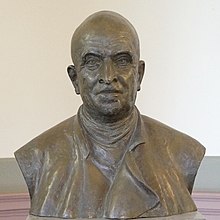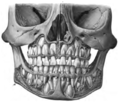Johannes Sobotta
Robert Heinrich Johannes Sobotta (born January 31, 1869 in Berlin ; † April 20, 1945 in Bonn ) was a German anatomist and founder of a world-famous anatomy atlas.
resume
Johannes Sobotta, son of an architect, attended the Royal Wilhelms-Gymnasium in Berlin until 1887 . From 1887 to 1891 he studied medicine at the Medical and Surgical Academy for the Military and at the University of Berlin. In 1891 he received his doctorate as Dr. med. with the topic: "About the structure and development of the uterus, especially in humans and monkeys". In 1892 he received his license to practice medicine. In 1891 Sobotta was initially a volunteer assistant and then from 1892 to 1895 3rd and 2nd assistant to Wilhelm von Waldeyer at the 1st Anatomical Institute of the University of Berlin. From February to October 1895 he stayed for a research stay at the Zoological Station in Naples . From 1895 to 1899 Sobotta was the histology prosector at the Institute for Comparative Anatomy , Embryology and Microscopy at the University of Würzburg (on the call of Albert von Kölliker ). In 1895/96 Sobotta's habilitation took place in Würzburg . In Würzburg he was prosector for "Anatomy and Anthropotomy" from 1899 to 1912, whereby in 1903 he was appointed first extraordinary and then in 1912 full professor for topographical anatomy. Sobotta introduced the dissection method according to Waldeyer and microphotography in Würzburg. It was here that his work on mammalian embryology, on the corpus luteum described by him for the first time, and his textbooks were created.
In 1916 Sobotta became full professor and director of the Anatomical Institute in Königsberg . From 1919 on, Sobotta was finally full professor and director of the Anatomical Institute in Bonn (successor to Robert Bonnet ). From 1924 he was a member of the editorial board of the "Journal for Microscopic-Anatomical Research". In 1926 he was accepted into the German Academy of Natural Scientists Leopoldina . In addition, Sobotta was assistant doctor first class of the Landwehr II, but apparently never in the war. Sobotta retired in 1935. In 1944 he was awarded the Goethe Medal for Art and Science .
Sobotta's grave monument is preserved in the Poppelsdorf cemetery in Bonn. Since November 2000 the Sobottaweg along the building of the Anatomical Institute of the University of Bonn in Poppelsdorf reminds of him.
The Atlas of Anatomy
The atlas of anatomy by Sobotta in three volumes, usually called “anatomy atlas ” for short, a standard work of medicine, has offered a mixture of realistic and explanatory atlas since the beginning of the 20th century. The first, like the most important of Sobotta's anatomical works in Würzburg, was published in three parts between 1904 and 1907 by JF Lehmanns Verlag, as were the following eleven editions up to 1944. After the Second World War, the Urban & Schwarzenberg publishing house acquired the rights to the anatomy -Atlas. Sobotta was able to win excellent draftsmen such as Karl Hajek and Erich Lepier for his atlas . Sobotta himself worked on the continuous improvement of his work until the end of his life in 1945. After his death, two editions appeared largely unchanged. In 1956 Hellmut Becher , anatomist in Münster , took over the further development of the anatomy atlas. He published the 14th to 17th edition. Under the editors Helmut Ferner , anatomist in Heidelberg and Vienna , and Jochen Staubesand, anatomist in Freiburg im Breisgau , the 18th edition of the atlas was completely revised in 1982 and divided into two volumes. In 1993 Reinhard Putz, anatomist at the Ludwig Maximilians University in Munich , and Reinhard Pabst, anatomist at the Medical University of Hanover , edited and further developed the atlas. The revised and restructured 23rd edition of the Sobotta Anatomy Atlas was published in September 2010 by Friedrich Paulsen, Institute for Anatomy at the University of Erlangen Nuremberg , and Jens Waschke , Chair of Anatomy I - Vegetative Anatomy at the University of Munich , now in Dutch Wissenschaftsverlag Elsevier , which acquired the Urban & Schwarzenberg publishing house , which had merged into Urban & Fischer , from the Holtzbrinck Group in 2003 . In 2017, the same authors published the 24th, revised edition by Verlag Elsevier.
- Illustrations from the 1906 edition
Skull with milk teeth
Mediastinum from the right lateral
Tendons of the hand
Structures of the retroperitoneal space
Pancreas and surrounding structures
Important publications
- 1901: Atlas and plan of the histology and microscopic anatomy of man. Munich
- 1904–1907: Atlas of descriptive human anatomy in 3 volumes. Munich
- 1904–1907: Outline of the descriptive human anatomy
- 1922: Atlas of the descriptive anatomy of man, Volume 1-3 - Internet Archive
- 1926: Atlas of Descriptive Human Anatomy Volume 1 - Internet Archive , Volume 3 - Internet Archive
literature
- Ferdinand Wagenseil: Johannes Sobotta: In memory of the 10th anniversary of his death. In: Anatomischer Anzeiger. Volume 101, 1955, pp. 265-280.
- Barbara I. Tshisuaka: Sobotta, Johannes. In: Werner E. Gerabek , Bernhard D. Haage, Gundolf Keil , Wolfgang Wegner (eds.): Enzyklopädie Medizingeschichte. De Gruyter, Berlin / New York 2005, ISBN 3-11-015714-4 , p. 1341.
- Ferdinand Wagenseil: Johannes Sobotta. In memory of the 10th anniversary of his death. In: Anatomischer Anzeiger. Volume 101, 1954/1955, pp. 265-280.
Web links
- Literature by and about Johannes Sobotta in the catalog of the German National Library
- Katharina Kayßer: Johannes Sobotta (1869–1945) - life and work with special consideration of his time in Würzburg. Dissertation , Julius Maximilians University Würzburg 2004, online (PDF file, 7, 63 MB)
- Biography (PDF file, 7 MB, pp. 3–7)
- Ralf Forsbach : The Medical Faculty of the University of Bonn in the “Third Reich” (1933–1945). Chapter 12: The corpses of Nazi victims in the Anatomical Institute. In: Portal Rhenish History. LVR , accessed June 27, 2019 .
Individual evidence
- ↑ Johannes Sobotta: About the formation of the corpus luteum in the mouse. In: Archives for microscopic anatomy. Volume 47, 1896, pp. 261-308.
- ↑ Reinhard Hildebrand: Rudolf Albert von Koelliker and his circle. In: Würzburg medical history reports. Volume 3, 1985, pp. 127-151, here: p. 148.
- ↑ Sobottaweg in Bonner Straße cadastral
| personal data | |
|---|---|
| SURNAME | Sobotta, Johannes |
| ALTERNATIVE NAMES | Sobotta, Robert Heinrich Johannes (full name) |
| BRIEF DESCRIPTION | German anatomist |
| DATE OF BIRTH | January 31, 1869 |
| PLACE OF BIRTH | Berlin |
| DATE OF DEATH | April 20, 1945 |
| Place of death | Bonn |








